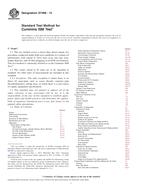Potřebujeme váš souhlas k využití jednotlivých dat, aby se vám mimo jiné mohly ukazovat informace týkající se vašich zájmů. Souhlas udělíte kliknutím na tlačítko „OK“.
ASTM D7647-10
Standard Test Method for Automatic Particle Counting of Lubricating and Hydraulic Fluids Using Dilution Techniques to Eliminate the Contribution of Water and Interfering Soft Particles by Light Extinction
Automaticky přeložený název:
Standardní zkušební metoda pro automatické částicové Počítání mazacích a hydraulických kapalin pomocí ředění techniky k eliminaci Příspěvek vody a Zasahování měkké částice by zeslabení světla
NORMA vydána dne 1.7.2010
Informace o normě:
Označení normy: ASTM D7647-10
Poznámka: NEPLATNÁ
Datum vydání normy: 1.7.2010
Kód zboží: NS-38886
Počet stran: 9
Přibližná hmotnost: 27 g (0.06 liber)
Země: Americká technická norma
Kategorie: Technické normy ASTM
Kategorie - podobné normy:
Maziva, průmyslové oleje a odpovídající výrobky
Hydraulické tekutiny
Anotace textu normy ASTM D7647-10 :
Keywords:
automatic particle counter, diluent, emulsified water, particle contamination, particle counting, soft particles, water-masking, ICS Number Code 75.100 (Lubricants, industrial oils and related products), 75.120 (Hydraulic fluids)
Doplňující informace
| Significance and Use | ||||||
|
This test method is intended for use in analytical laboratories including onsite in-service oil analysis laboratories. Hard particles in lubricating or fluid power systems have a detrimental effect on the system as they cause operating components to wear and also accelerate the degradation of the oil. Hard particles in the oil originate from a variety of sources including generation from within an operating fluid system or contamination, which may occur during the storage and handling of new oils or via ingress into an operating fluid system. High levels of contaminants can cause filter blockages and hard particles can have a serious impact on the life of pumps, pistons, gears, bearings, and other moving parts by accelerating wear and erosion. Particle count results can be used to aid in assessing the capability of the filtration system responsible for cleaning the fluid, determining if off-line recirculating filtration is needed to clean up the fluid system, or aiding in the decision of whether or not a fluid change is required. To accurately measure hard particle contamination levels, it is necessary to negate the particle counts contributed by the presence of small levels of free water. This method includes a process by which this can be accomplished using a water-masking diluent technique whereby water droplets of a size below the target level are finely distributed. Certain additives or additive by-products that are semi-insoluble or insoluble in oil, namely the polydimethylsiloxane defoamant additive and oxidation by-products, are known to cause light scattering in automatic particle counters, which in turn causes falsely high counts. These and similar materials are commonly termed “soft particles” (see 3.1.5) and are not known to directly increase wear and erosion within an operating system. The contribution of these particles to the particle size cumulative count is negated with this method. The use of dilution in this test method counteracts viscosity effects for highly viscous oils that impact the accuracy of automatic optical particle counting results. |
||||||
| 1. Scope | ||||||
|
1.1 This test method covers the determination of particle concentration and particle size distribution in new and in-service oils used for lubrication and hydraulic purposes. 1.2 Particles considered are in the range from 4 µm (c) to 200 µm (c) with the upper limit being dependent on the specific automatic particle counter being used. Note 1—For the purpose of this test method, water droplets not masked by the diluent procedure are detected as particles, and agglomerated particles are detected and reported as a single larger particle. Note 2—The subscript (c) is used to denote that the apparatus has been calibrated in accordance with ISO 11171. This subscript (c) strictly only applies to particles up to 50 µm. 1.3 Lubricants that can be analyzed by this test method are categorized as petroleum products or synthetic based products, such as: polyalpha olefin, polyalkylene glycol, or phosphate ester. Applicable viscosity range is up to 1000 mm2/s @ 40°C. This procedure may be appropriate for other petroleum and synthetic based lubricants not included in the precision statement. 1.4 Samples containing visible particles may not be suitable for analysis using this test method. 1.5 Samples that are opaque after dilution are not suitable for analysis using this test method. 1.6 The test method is specific to automatic particle counters that use the light extinction principle and are calibrated according to the latest revision of ISO 11171. 1.7 The values stated in SI units are to be regarded as standard. No other units of measurement are included in this standard. 1.8 This test method does not purport to address all of the safety concerns, if any, associated with its use. It is the responsibility of the user of this standard to establish appropriate safety and health practices and determine the applicability of regulatory limitations prior to use. |
||||||
| 2. Referenced Documents | ||||||
|
Podobné normy:
Historická
1.5.2013
Historická
1.12.2011
Historická
1.5.2013
Historická
15.4.2012
Historická
1.5.2014
Historická
1.5.2013



 ASTM D7419-13
ASTM D7419-13 ASTM D7421-11
ASTM D7421-11 ASTM D7450-13
ASTM D7450-13 ASTM D7452-12
ASTM D7452-12 ASTM D7455-14
ASTM D7455-14 ASTM D7468-13
ASTM D7468-13
 Cookies
Cookies
